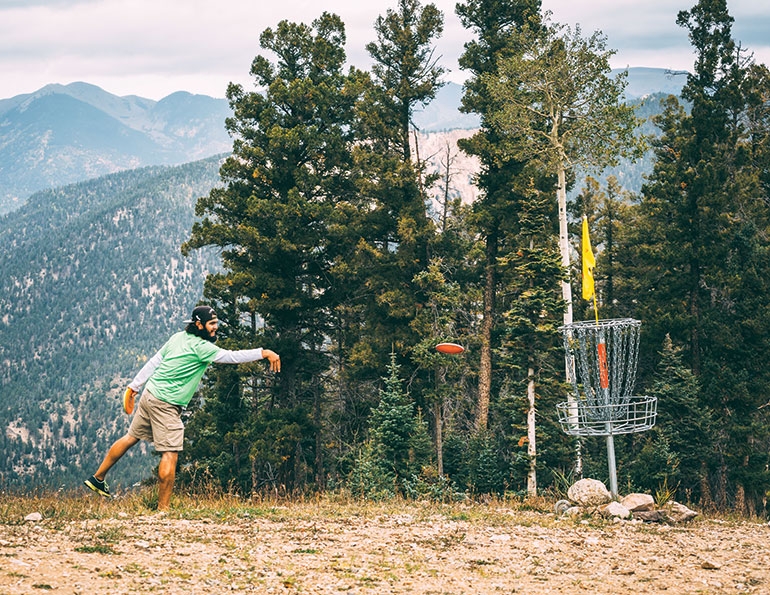When New Mexico’s Red River Ski & Summer Area introduced its scenic summer chairlift ride more than 60 years ago, operators could not have foreseen what summer at the resort would become. Despite this rich history, it wasn’t until 50 years later that Red River really focused on beefing up summer amenities.
The push for summer made sense, says GM Linton Judycki. The town of Red River sees about three times as many tourists in summer as it does in winter, with roughly 75 percent driving in from Texas. So, in 2009, resort managers decided it was time to capitalize on that market, systematically adding a host of features that include 800-foot-long summer tubing lanes, an 18-hole disc golf course, zip lines, an aerial park, and a challenge tower.
“The idea was to create a solid day of operations for people who might want to stay for half or a whole day,” says Judycki.
Red River wasn’t alone—many U.S. ski areas decided to get into summer around that same time. Now, a decade or so in, they’ve had time to analyze summer operations, add new features, hone pricing, and focus on different markets, all while gaining an understanding of the distinct difference between their two main operating seasons.
Day In, Day Out
Ski areas have tweaked their offerings and pricing since those early days, with the hopes of keeping customers on property for a full day—a stark contrast to some of the single-ride tickets of earlier years. Operators realized that keeping people around, and providing activities for all ages and ability levels, is a boon for lodging, F&B, and retail.
Oregon’s Mt. Hood Skibowl already had an alpine slide when Kirk Hanna purchased the ski area in 1987. Under Hanna’s ownership, that summer operation has blossomed to include more than 20 attractions meant to draw families for a full or half day.
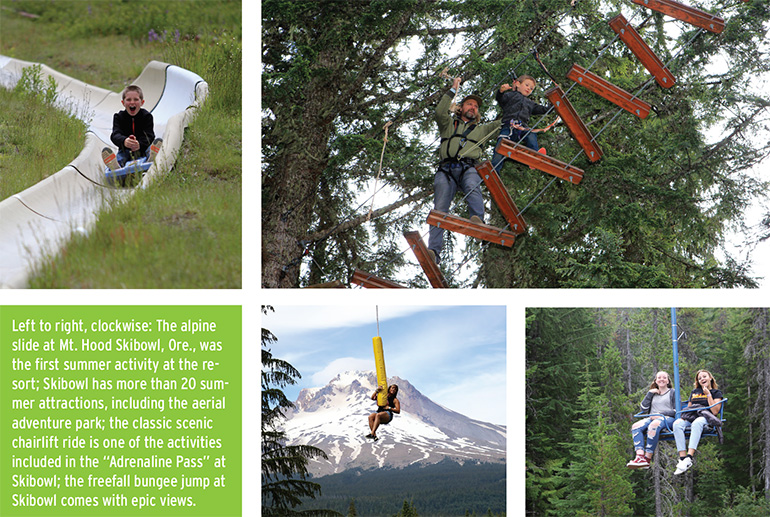
Packaged pricing. GM Mike Quinn says the resort relies on packaged pricing to keep folks on site. “The more packaging you can do, the more likelihood people will spend longer periods of time at your resort,” says Quinn, who adds that Skibowl has moved away from a la carte attraction pricing in favor of bundling.
Skibowl’s summer fare includes the “Adrenaline Pass,” a $79 day ticket (2021 price), which offers unlimited use of most activities, including the alpine slide, chairlift, and disc golf, and a deep discount ($7 per ride) on “premium attractions” like the freefall bungee jump and zip line.
The Aerial Effect
Skibowl’s current roster of summer activities includes 800 feet of zip lines, installed in 2006, and a treetop bridge tour, installed almost a decade later in 2015. This turn toward aerial elements has been a sort of second wave of summer additions that many ski areas with the right layout have embraced in the past five to seven years.
New York-based Outplay Adventures has designed, built, and installed aerial parks at ski areas including Stowe, Vt., Snow King, Wyo., and Camelback, Pa. President David Johnson says that aerial attractions provide a great framework for an all-day ticket model, and are a good option for families striving to get the most bang for their buck. “Families are trying to extend their vacation dollars as much as possible,” says Johnson. Including a mix of simple activities and aerial adventures, such as a multi-hour ropes course, in a package offers good value.
Red River offers aerial adventure in the form of its Pioneer Flyer seated zip line and Hidden Treasure aerial park. It, too, bundles activities with passes—the Explorer Gold Mine pass includes unlimited chairlift, zip line, mountain tubing, and mini golf access and one session in the Hidden Treasure park for $110 (2021 pricing). The Lil’ Explorer Gold Mine pass offers the same for kids for $50, less the aerial park.
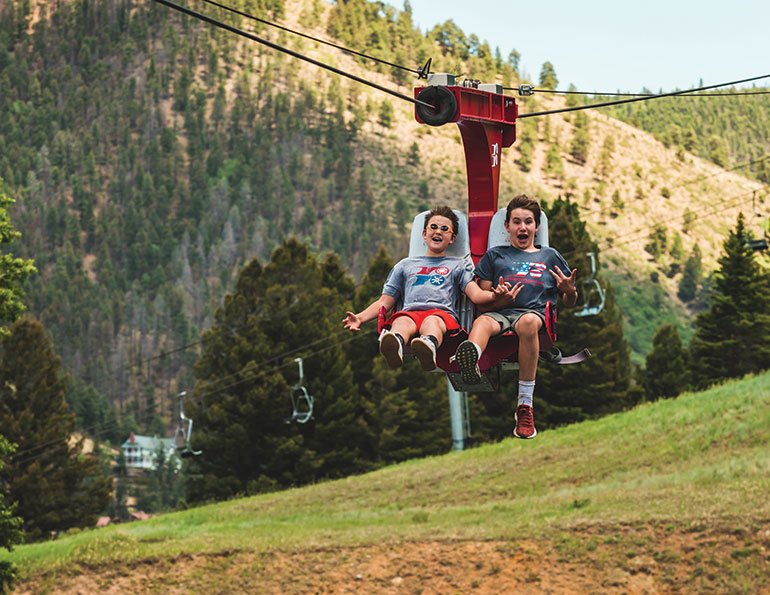 The Pioneer Flyer, a seated zip line, is one of two aerial attractions at Red River.
The Pioneer Flyer, a seated zip line, is one of two aerial attractions at Red River.
Self-guided. Judycki says that to accommodate more folks and encourage them to stay, Red River has kept some Covid policies that worked well. For one, instead of the guided tours for its treetop course, which left every 1.5 hours and deterred folks who didn’t want to wait around, it now offers smaller, self-guided groups (6-8 people) that leave every half hour. “That seems to help out and give a little leeway by creating smaller groups but more often,” he says.
Kid-Centric
Like many resorts, Red River has also realized the importance of getting all age groups involved, and has specifically shifted its focus to younger kids in recent years.
“We definitely have our eyes open to the 3- to 5-year-old demographic and will continue to do so in the coming years,” says Walter Foley, resort deputy general manager and director of planning and development.
Red River recently added options for this younger set, including a tiny 50-foot tubing track, a temporary mini golf course, a four-mile interpretive hiking trail that goes from summit to base, and a gold panning/sluicing operation, which will debut this summer.
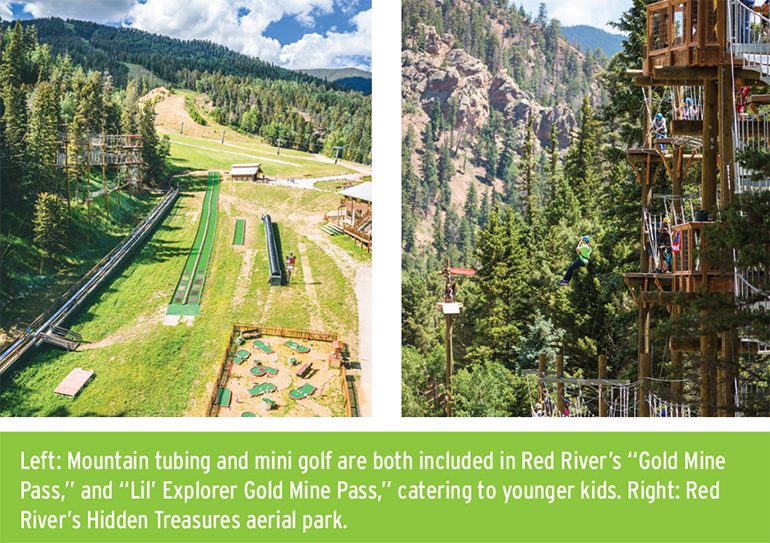
There are plenty of kid-centric activities on the market. Didier Bachaumad, global sales director of The Trekking Group, says its Treewalk Village kids’ aerial playground and Wondernet netted features are the most in-demand right now. With the education system changing, says Bachaumad, more families are seeking kids’ activities.
Attraction planning. Bachaumad says The Trekking Group is building netted-treetop features next to ropes courses to provide options for all ages. “This offers something for everyone—they can all have a different activity,” he says. “When we build a ropes course next to a Treewalk Village, it’s more than doubling your visitation. And when you have something like Treewalk Village or a canopy tour, it’s not a two-minute thrill, then done. Visitors stay two hours. They bring friends. They meet people. It’s a real village.”
“Always remember it’s about the families, not the thrill seeker,” adds Red River’s Foley. “For us, the popularity of zip lines, for example, has slowed down. We’re kind of thinking outside the box on those kinds of things now.”
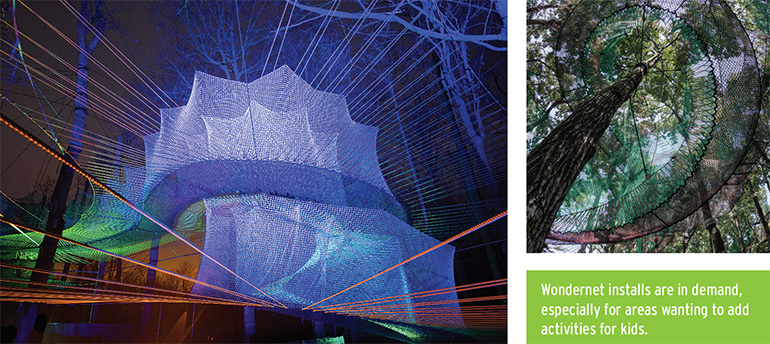
Less is More?
The Massachusetts-based Fairbank Group, whose portfolio includes Jiminy Peak, Mass., Cranmore Mountain, N.H., and Bromley, Vt., has overseen the growth of summer operations at all three destinations. Jiminy has had an alpine slide since 1977, and starting in the 1990s, added several small elements—a four-plex trampoline, climbing walls, mini golf, bouncy houses—that didn’t require a big capital expense, because so much was going into winter operations, says CEO Brian Fairbank.
In 2005, the approach changed. Jiminy added a mountain coaster—a significant investment that complemented its alpine slide—and later, a 1,000-foot family zip line and an aerial adventure park. “The summer tourist that we were drawing could be coming just for aerial adventure or mountain park activities, or both,” says Fairbank. “That became the same concept we applied at Cranmore and Bromley.”
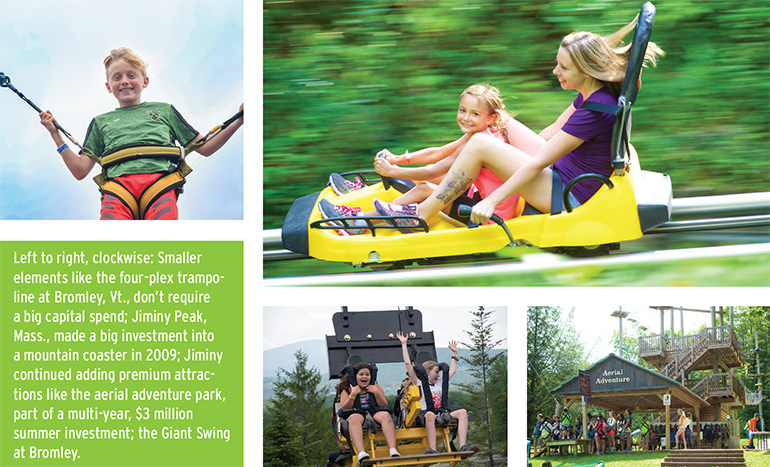
Fairbank says that after the initial few years of investment, which at Jiminy totaled about $3 million, his group has taken a relatively circumspect approach to further summer capital expenditures at the three resorts. Why?
Complementary—not competing—activities. “This issue to consider is, ‘Will [expansion] cannibalize existing business?’” says Fairbank. For example, Jiminy’s aerial adventure park boomed at first, but partially because it siphoned some visitors from the resort’s other activities. “Be careful and make sure you’re not putting in something that’s going to erode your current revenue base,” he cautions.
Johnson agrees that less is often more. “When the ski hills decided they wanted summer activities, a lot went a little too far, too fast,” he says. “They thought, ‘We need bungee jumping, an aerial adventure park, coasters, high speed zip lines, etc.’ I think they sort of overwhelmed their consumer by giving them too many choices. Now, a lot of ski resorts have gone away from some of the peripheral stuff.”
“Resorts are more methodical than five or eight years ago, when they would make an investment, and half a season in realize the mistake,” adds Tim Bruce, senior loss control specialist at insurer Safehold Special Risk. “Now, they’re thinking more, ‘What’s the ROI?’ The winter example is bag jumps—resorts thought they were going to use them in winter and summer. They’re a lot more methodical about the purchase and ‘Can we staff it?’ and ‘What’s the throughput going to be like?’”
Expansion planning. Fairbank says his resorts benefitted from having a solid expansion plan from the start. “Really think about master planning every component of your summer operations,” he advises. “In terms of your physical plan, what can go in certain places? Think about timing: What can I add each summer? And from a cash flow standpoint: What can I afford to do in the next years?”
“Adding attractions should complement what you’re already doing, or set you up to move in a different direction should you wish, for any reason, to move away from an existing attraction or business model,” says Skibowl’s Quinn.
Think about your operations from the guest’s point of view, Johnson says. “If you vacation at, say, Stowe every summer, you want to see something new,” he notes.
One option for a refresh is to rearrange or add onto existing adventure park features rather than invest in completely new attractions, he adds. To accommodate this, Outplay often creates a larger master design, then installs a portion of it in the initial build. As a result, future expansion takes less hassle and expense. Outplay has done such refreshes at its parks by adding games, changing courses, or incorporating new elements.
The People Factor
One of the most vital components of year-round operations? The people factor. Fairbank notes that with the installation of its Alpine slide, Jiminy went from five year-round employees to 25.
“While there was a financial benefit, by far the biggest benefit was people,” says Fairbank. “All three mountains wound up getting summer revenue, but more importantly, they benefited with the heartbeat of people. Many of those people are still there today. Their year-round life’s work is to get up every day and think about the resort, and they became faithful employees.”
At Red River, too. “It’s been a cool change,” says Judycki. “We were able to keep a core group of managers and supervisors year-round, which makes for a more efficient operation.”
Insurance
When it comes to the less-sexy side of summer—insurance—Safehold’s Bruce says not much has changed except resort operators’ grasp on the topic.
“Resorts have the Skier’s Protection Act in the winter to fight against frivolous lawsuits,” he says. “In the summer, you don’t have that protection. This was a hard concept for operators to understand at first.”
Documentation. Summer and winter ops become almost two different businesses, notes Bruce. “Right now, we’re in winter loss control, but in summer we’ll go to bike parks, water features,” he says. “We ask a lot of the same questions regarding releases, but we really dive more into record keeping and training. If we do get litigation, that’s the first thing we’ll look at—who did the training. It’s even more imperative in the summer for operators to not stray from the handbook, because then they sort of own the whole process in a different way.”
Bruce notes that some summer attraction vendors have gone out of business in recent years as well, so resorts need to be up to speed on their contracts. “It’s usually solid,” says Bruce, “but it’s more about, ‘how will the resort be protected if something happens?’ We’re really gung-ho on contracts and agreements with any third-party vendor.”
Next Steps
As summer has come into its own, ski areas are taking time to analyze their next steps. They’ve added amenities and met some goals; now they’re looking carefully at what they can improve on next.
Climate change is a factor. The threat of climate change, Quinn says, means Skibowl will keep its growth focus on summer. “We are very summer centric, and need to be more so as we move into the future,” he says. “With climate change and potentially bad snow years, our focus on summer revenue is paramount.”
Now that Red River has met its goal to offer a solid day of activities, Judycki says it’s time to reevaluate and see how it’s best to grow.
He notes that the IAAPA (International Association of Amusement Parks and Attractions) show has been a great source of ideas as far as looking at equipment, and that the SAM Summer Ops Camp has been great for brands and connections. He also visits and communicates with other ski areas.
“We like to go around to check out other operations and see what they are doing,” he says. “That’s kind of how we do the research. We’re all doing the same sorts of things that revolve around mountains and chairlifts. Having that common denominator is nice, and so is understanding each other’s winter operations and how summer ties in.”




